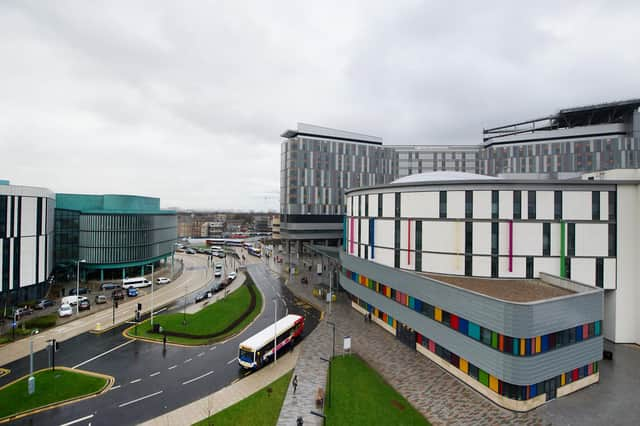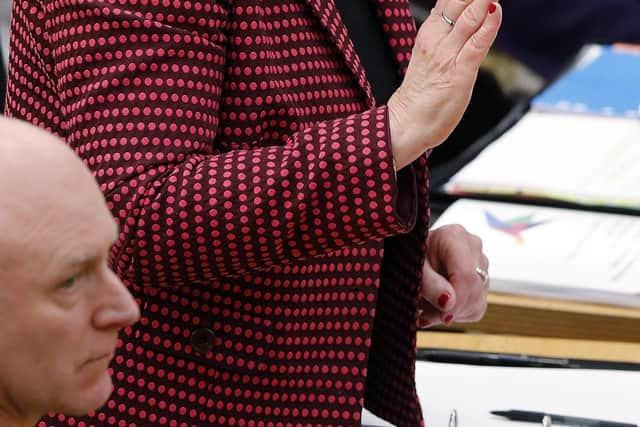Family want truth over 'pigeon dropping' infection death


Gail Armstrong was 73 and had been treated for blood cancer in Glasgow's Queen Elizabeth University Hospital before she died in January last year.
In the weeks before her death she had contracted a Cryptococcus infection.
Advertisement
Hide AdAdvertisement
Hide AdPigeon excrement at a plant room on the 12th floor in the hospital was at first thought to be the "likely source".


The health board later ruled out the plant room and an independent review, published last week, said there was "not a sound evidential basis" on which to make a link between the Cryptococcus neoformans infections and the presence of pigeon excrement at the hospital.
Cryptococcus is widely present in the environment but can be lethal to patients with compromised immune systems.
Gail Armstrong died on 7 January 2019, just weeks after the infection had been a "contributory factor" in the death of a 10-year-old boy at the hospital campus.
Gail's daughter Beth told the BBC's Disclosure programme The Secrets of Scotland's Superhospital that the family had now lost trust that Glasgow's health board would be honest and open about the cause of her death.
The family maintain that the infection was contracted in the hospital and that, although she was terminally ill with lymphoma, it hastened her death because she was unable to get the treatment she needed.
Gail, who lived in the Queen's Park area of Glasgow, was described by her family as a "caring, loving and very active" woman, with a hunger for life.
Advertisement
Hide AdAdvertisement
Hide AdHer husband Jim Cowan said his wife had a "great spirit of adventure" and would make plans every day even after being diagnosed with cancer.
He said she was being treated for lymphoma at Scotland's £840m flagship hospital when her condition suddenly became much worse.
Her husband said the hospital could not "get to the bottom" of what her infection was but they needed to clear it before they could start chemotherapy again.
According to Gail's daughter Beth: "One day the consultant came in and said to us 'we've identified the source of the infection and it's called Cryptococcus, and it's a really nasty infection that comes from pigeons'."
Beth said the infection knocked her mum "for six".
"She really took a nosedive," Beth says. "She became very weak, lost the use of her legs, you know her brain was getting a bit scrambled."
Two weeks after Gail's death, Health Secretary Jeane Freeman made a statement to parliament in which she told MSPs that Cryptococcus was not a contributory factor in her case.
She told MSPs that the 73-year-old had been discharged for palliative care and later died.
Gail's family told the Disclosure programme that the bacteria had been identified in November and she was only in palliative care for the last six days of her life in early January.
Advertisement
Hide AdAdvertisement
Hide AdUntil she contracted the infection, they said she had been expecting to start a new kind of chemotherapy to treat her cancer.
Her husband Jim said she was treated with an extremely expensive anti-fungal medication to tackle the infection so they could restart chemo.
The death of Gail and the 10-year-old, who was never identified, prompted a series of investigations into the design and build of the hospital.
The first major one to report was a review into the fabric of the building, which took almost a year-and-a-half to complete, and has just published its findings.
Epidemiologist Dr Kevin Pollock said: "The primary source of infection for Cryptococcus in individuals in the northern hemisphere is pigeon faeces.
"I think the fact that you have two cases in space and time within a month of each other in an environment where potentially you have a large amount of pigeon faeces, that's what I'd call the smoking gun hypothesis."
The Armstrong family says the latest review has added to a sense that the authorities are not being straight with them.
Gail's daughter Beth said: "We have less trust in the health board to be transparent and frank and honest and open. And it makes me feel worried that the truth is never really going to come out."
Advertisement
Hide AdAdvertisement
Hide AdNHS Greater Glasgow and Clyde did not want to provide an interview and said it could not comment on individual cases.
However, Health Secretary Jeane Freeman said Court of Session judge Lord Brodie had been appointed to chair a public inquiry into the issues surrounding the hospital, which also include problems with the ventilation system and water contamination in the adjacent children's hospital.
"I can understand why families are at this point sceptical about what might come out of any inquiry or investigation," she told Disclosure.
"What I regret is that some of those answers have not been provided sooner," she said.
Disclosure: The Secrets of Scotland's Superhospital is on BBC One Scotland at 20:00 on Wednesday 24 June.
A message from the Editor:
Thank you for reading this story on our website. While I have your attention, I also have an important request to make of you.
The dramatic events of 2020 are having a major impact on many of our advertisers - and consequently the revenue we receive. We are now more reliant than ever on you taking out a digital subscription to support our journalism.
Subscribe to scotsman.com and enjoy unlimited access to Scottish news and information online and on our app. Visit https://www.scotsman.com/subscriptions now to sign up.
By supporting us, we are able to support you in providing trusted, fact-checked content for this website.
Joy Yates
Editorial Director
Comments
Want to join the conversation? Please or to comment on this article.